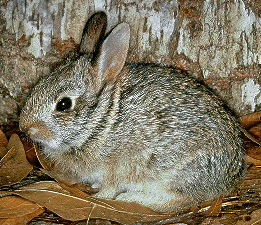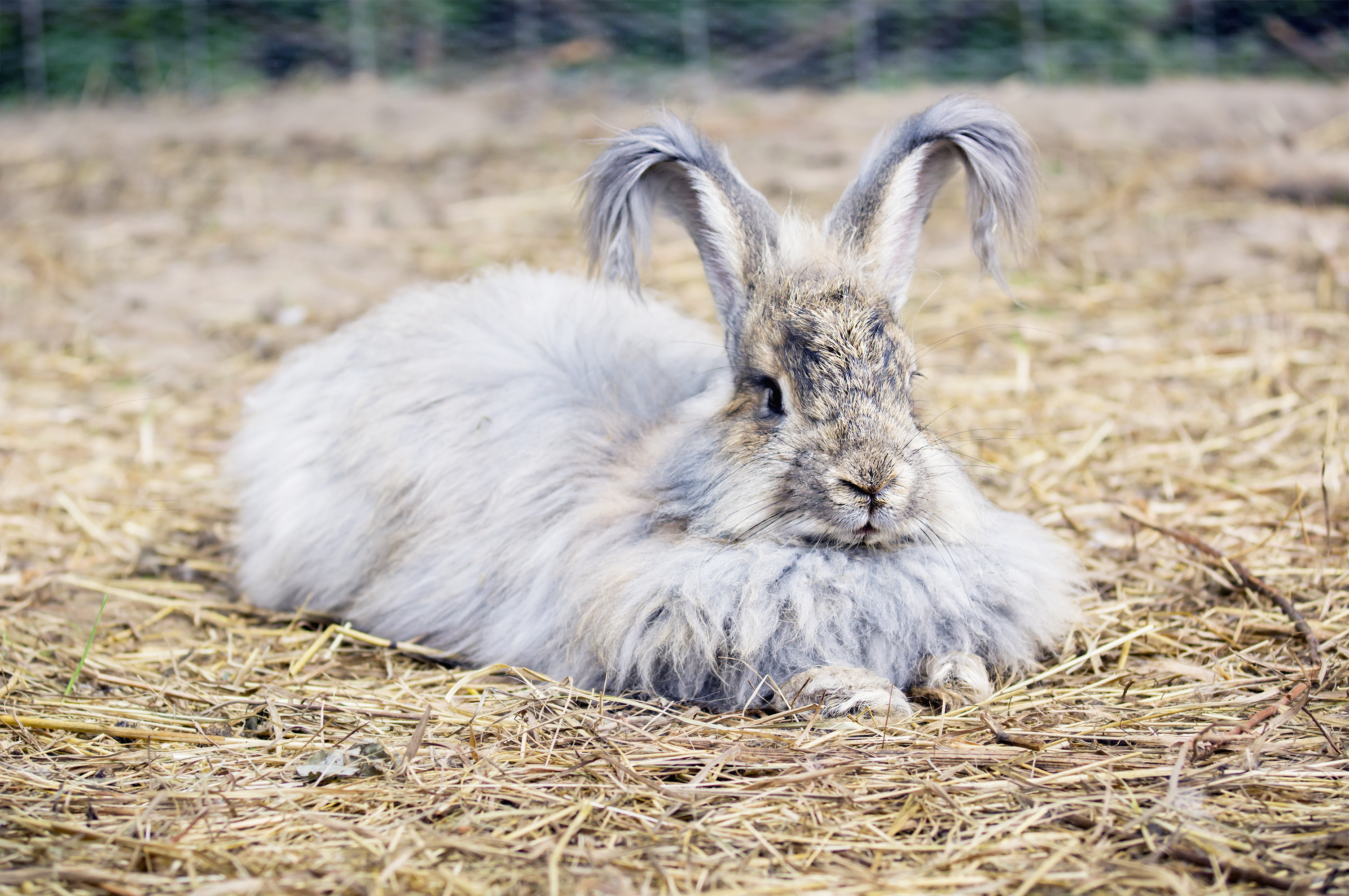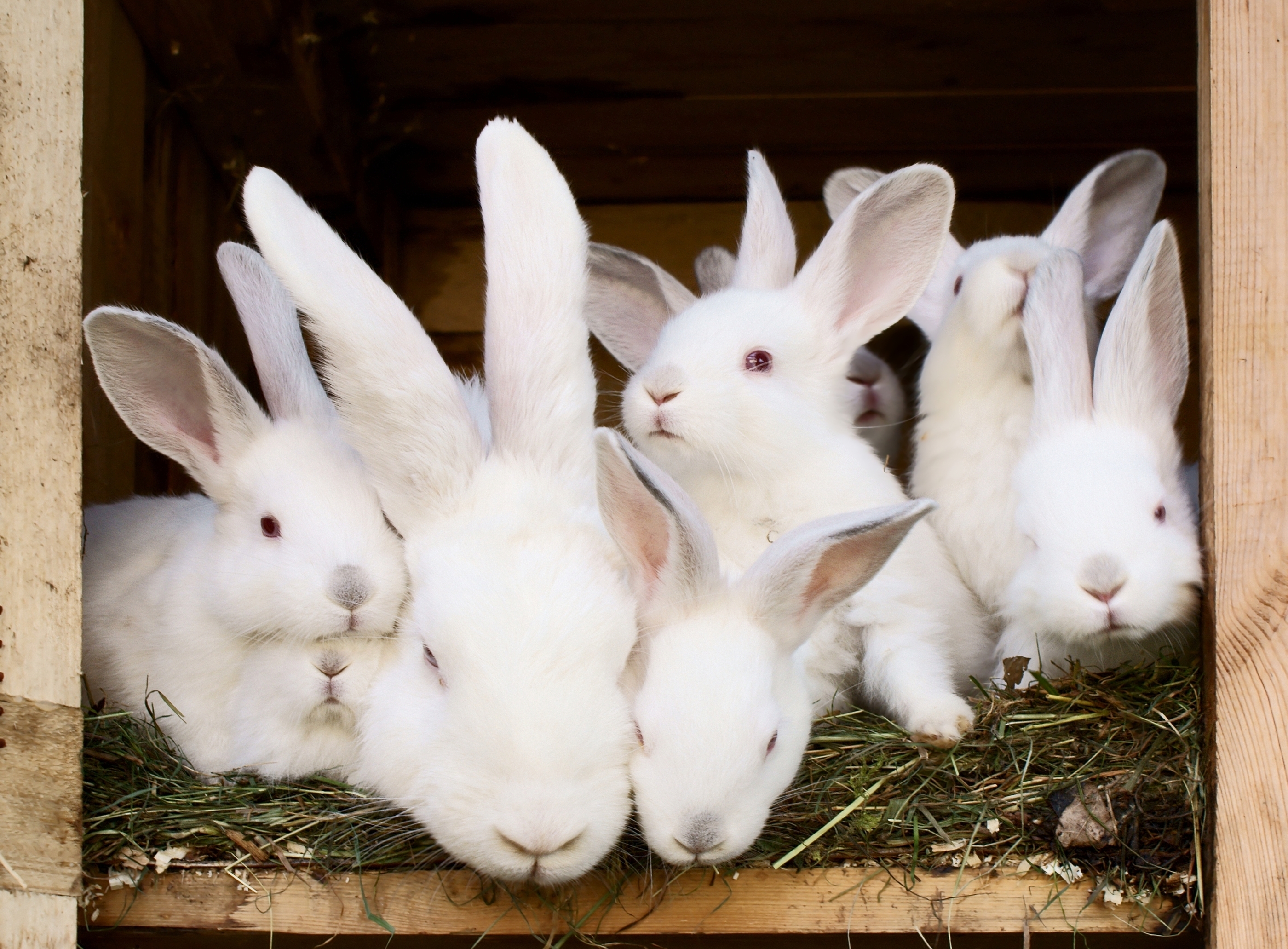Rabbit is a furry animal with long ears and a short, fluffy tail. Wild rabbits live throughout the world in all climates. Tame varieties of rabbits make excellent pets.
Rabbits are closely related to hares. Rabbits and hares look similar and are often mistaken for one another. Some rabbits and hares are misnamed. For example, the Belgian hare is a rabbit, and the jack rabbit is a hare. Rabbits and hares can be told apart most easily at birth. Newborn rabbits have no fur and are blind and helpless. Newborn hares have fur and their eyes are open. Also, mother rabbits shelter their young in a soft, fur-lined nest. Mother hares do not make nests for their young.
Kinds of rabbits
Biologists classify rabbits into 10 groups called genera and into many species within the genera. Numerous species, such as the volcano rabbit of Mexico, have become rare. The most widespread rabbits are cottontails and European rabbits. Domestic rabbits are tame varieties of European rabbits.
Cottontails
are wild rabbits of North America and parts of Central and South America. Most species have fluffy white fur on the underside of the tail. Perhaps the most common species is the eastern cottontail. Cottontails inhabit fields, prairies, marshes, and swamps—wherever they can find bushes or clumps of tall grass in which to hide. They may also live in wooded areas bordering open country.

European rabbits
originally lived in southern Europe and northern Africa, and on some western Mediterranean islands. From these places they spread throughout Europe. People brought European rabbits to many other parts of the world, including Australia, New Zealand, and South America. Rabbits have often become pests in these regions. The animals reproduce quickly in areas where they have few natural enemies, and they can present a threat to plant life.
Domestic rabbits
are raised for their meat and fur, for use in scientific research, and as pets. People around the world eat rabbit meat, which is tasty and nutritious. Rabbit breeds raised commercially for meat include the Californian and New Zealand. Many people raise other breeds for meat in small backyard “rabbitries.”
Artificial furs have largely replaced rabbit fur in clothing. However, people still raise the Angora rabbit for its long fur, which is spun into a soft, warm yarn. Rabbit fur is also used in making stuffed toys.

The use of rabbits in research laboratories requires great numbers of highly similar animals, which only large commercial breeders can provide. The Californian, Florida White, and New Zealand White are breeds frequently used in laboratories.
Many of the more than 40 rabbit breeds are raised for show or as pets. Popular show breeds include the Californian, Dutch, Holland Lop, Mini Rex, Netherland Dwarf, and Satin. Judges rate rabbits on such features as size and shape, and the quality and color of the fur. Favorite pet breeds include the Netherland Dwarf, Dutch, Holland Lop, and Mini Lop. The ears of the English Lop may grow more than 2 feet (60 centimeters) long.
The body of a rabbit
Wild rabbits have brownish fur that mixes white, light brown, gray, dark reddish-brown, and black hairs. Domestic rabbits may be black, brown, gray, white, or even spotted in various combinations of these colors.
An adult cottontail rabbit grows about 211/2 inches (55 centimeters) long and can weigh up to 6 pounds (2.7 kilograms). European rabbits may be somewhat smaller. Domestic rabbits can grow larger than wild rabbits. The White Flemish Giant, the largest breed of rabbit, weighs up to 17 pounds (8 kilograms). The smallest species of rabbit, the volcano rabbit, measures only about 12 inches (30 centimeters). Female rabbits, called does, tend to grow larger than males, called bucks. In most species, the tail of a rabbit measures about 3/5 to 23/4 inches (1.5 to 7 centimeters) long and is covered with soft, fluffy fur.
Rabbits generally move in a hopping motion using their long, powerful hind legs. This motion enables them to travel quickly. A rabbit’s hind legs have long toes hidden beneath a thick cushion of fur. The toes are webbed to keep them from spreading when the rabbit jumps.
A rabbit’s eyes are on the side of its head, toward the back. As a result, the animal can see better to the side than forward. A rabbit’s keen sense of smell helps alert it to danger. But rabbits rely mostly on their hearing. They may move their long, sensitive ears together or one at a time to catch sounds from any direction. The ears also keep the rabbit cool in hot weather by giving off heat.
Rabbits’ teeth grow continually throughout their lives. Their chisellike front teeth, the upper incisors and lower incisors, resemble those of rodents. Unlike rodents, rabbits have two pairs of upper incisors. One pair is directly behind the other. Rabbits use the incisors to gnaw and clip off plants. They then chew their food with sideways movements of the lower jaw, which grinds the food and helps wear down the ever-growing teeth.
The life of a rabbit
Rabbits have many natural enemies and can protect themselves mainly by hiding or running from danger. Although pet rabbits may live as long as 10 to 15 years, wild rabbits rarely survive beyond 6 years of age.
Homes.
Cottontail rabbits spend most of the daylight hours resting in shallow depressions in the ground called forms. In cold weather underneath deep snow, a cottontail may take over another wild animal’s abandoned burrow and make a network of connected paths called runs. Cottontails live mostly solitary lives, but they share territory with others and come together for mating. The pygmy rabbit constructs its own burrow.
European rabbits live in large colonies and will warn one another about danger by making loud thumps with their hind feet before running off. They share vast underground burrows called warrens. Warrens may be dug up to 10 feet (3 meters) underground and have several entrances and exits. They consist of interconnecting tunnels, living chambers, and nesting chambers where females give birth to and nurse their babies.
Food.
Most rabbits eat and play from dusk to dawn, and spend the day resting and sleeping. In spring and summer, rabbits eat green leafy plants, including clover, grass, and herbs. In winter, they eat the twigs, bark, and fruit of bushes and trees. Rabbits sometimes damage crops because they nibble the tender sprouts of beans, lettuce, and other vegetables.
The plant foods that rabbits eat are hard to digest. To get the most nutrients from these foods, rabbits pass the plant matter through their digestive system more than once. Rabbits produce two kinds of solid wastes: moist pellets, which they swallow again and redigest, and solid pellets, which are true wastes.
Loading the player...Cottontail foraging
Young.
Because wild rabbits often die before reaching maturity, they must produce many young to survive. A female rabbit usually has four to five young at a time, and she may give birth several times a year. Female cottontails may bear about four litters of young per year.
A female cottontail rabbit carries her young, called kits, inside her body for 26 to 30 days before giving birth. The mother keeps the newborns in a nest she has dug in the ground. She lines the nest with fur pulled from her chest with her teeth. The mother stays near the nest and covers the kits with grass and fur to keep them warm. Kits develop a coat of soft fur around 10 days after birth.
About two weeks after birth, the kits can leave the nest for short periods. When the kits are three to four weeks old, they leave the nest permanently. Cottontail rabbits reach maturity in under a year.

Enemies.
People rank as the greatest enemies of rabbits. Every year, hunters kill millions of rabbits for sport and for food. Farmers kill rabbits to protect crops. Human beings also kill rabbits by destroying the animals’ natural habitats. Other rabbit enemies include coyotes, foxes, weasels, snakes, hawks, and owls.
Rabbits usually try to hide from enemies. If a rabbit is in the open, it may sit still, unnoticed, and wait for the foe to go away. If the enemy comes too close, the rabbit flees. A frightened rabbit can leap 10 feet (3 meters) or more and can travel as fast as 25 miles (40 kilometers) an hour. But it tires quickly. It tries to confuse its enemy by zigzagging. It sometimes circles back and follows its own trail for a while, and then leaps off in another direction. It may dive into a burrow or into brush to escape.
Wild rabbits often die from the disease tularemia, also known as rabbit fever. Tularemia can spread to people who handle sick rabbits (see Tularemia ).
Pet rabbits
Many people keep domesticated rabbits as pets. All rabbits initially avoid human contact. Rabbit owners must use frequent, gentle handling to teach their pets not to fear people. Owners also need to provide proper cages, food, and medical care for these animals.
Handling.
Never pick up a rabbit by the ears. Lifting it that way can cause pain and injury to the rabbit. Instead, grasp the animal by the scruff of the neck with one hand and support its rear quarters with the other hand. You can also hold a rabbit against your body by using the crook of the supporting arm’s elbow to cover the animal’s head. Use both hands to restrain its rump and rear legs. Rabbits scratch or sometimes bite people who have not restrained them properly. They can also break their own backs or legs if allowed to struggle too much.
Cage.
You can buy a hutch (rabbit cage) at a pet store, or you can build one. Rabbits may be housed outdoors or indoors as long as they have good ventilation. Elevate outdoor hutches to prevent predators from reaching the rabbits and to help keep the rabbits healthy. Outdoor hutches must also protect rabbits from rain, wind, direct sunlight, extreme cold and heat, and wild animals.
When constructing a hutch, use cleanable materials that are strong enough to withstand a rabbit’s chewing. Such materials include wire mesh, sheet metal for roofing, and hardwood framing. Make the hutch large enough for the rabbit to move freely. Provide food and water bowls that the animal cannot tip over and cannot chew. Rabbits can also learn to drink water from siphons (sucking tubes). Rabbits should have safe, indestructible toys and chew sticks to prevent boredom. Remove uneaten food and waste from the hutch each day and clean the hutch thoroughly at least three times a week. Rabbits kept indoors can learn to use a litter box.
Male rabbits may fight with one another and even kill baby rabbits. Owners should house them individually.
Food.
Rabbits have sensitive digestive systems. They do best when their diets consist mainly of high-quality commercial rabbit pellets. Supplement the main diet with hay or straw to provide fiber. Fiber helps prevent hairballs and other serious intestinal problems. Owners can also feed rabbits small amounts of bread, tender tree growths, and such fruits and vegetables as apples, cabbage, cauliflower, leaf lettuce, spinach, and turnips.
Do not give your rabbit all the day’s food at once. Two meals each day help prevent boredom. Provide water and a mineral block at all times. Mineral blocks, also called salt licks, are blocks of salt injected with other minerals that the animal needs.
Health.
Owners must brush pet rabbits at least once a week, especially when the animals molt (shed their hair). Molting occurs about once a year. Long-haired breeds, such as the Angora, must be brushed every day. Excess hair licked off by the rabbit can cause a hairball to form in the stomach. During brushing, examine the rabbit for ear mites, fur mites, and fleas. Consult a veterinarian if you find such parasites.
Trim your rabbit’s toenails if they do not wear down naturally. The animal also may need its teeth trimmed by a veterinarian if the teeth have grown irregularly. Signs of bad teeth include drooling and lack of appetite.
Rabbits not used for breeding should undergo neutering (removal of some of the sex organs) between 4 and 6 months of age. Female neutering, called spaying, removes the ovaries and uterus and prevents uterine cancer, a common cause of death among does. Male neutering, called castration, can make bucks less aggressive.
Owners should not ignore any signs of illness in rabbits because the animals often die quickly from disease. Signs of disease include diarrhea, runny eyes, sneezing, and loss of appetite.
See also Hare; Jack rabbit.
